Weekly Portfolio: OPM, PRINCE 2, and Project Management Tools
VerifiedAdded on 2021/06/18
|15
|3364
|49
Project
AI Summary
This student's weekly portfolio comprehensively explores project management methodologies, organizational project management (OPM), and the PRINCE 2 framework across several weeks. The portfolio delves into the importance of adopting suitable methodologies for project success, emphasizing the significance of organizational culture and structure in project-oriented environments. It highlights key concepts such as the alignment of strategic goals with OPM principles, the role of change management, and the differences between PMBOK and PRINCE 2 approaches. The portfolio further examines the practical implementation of OPM, including strategic alignment, the use of case studies, and the necessary change management processes. It also covers the use of various project management tools, including Work Breakdown Structures (WBS) and their role in successful project execution. The portfolio integrates readings, lecture notes, and personal reflections to provide a holistic understanding of the subject matter, supported by relevant journal articles and standards. The assignment details the importance of stakeholder management, team dynamics, and the use of various tools for successful project implementation. Overall, the portfolio provides a detailed overview of OPM implementation, its constraints, and the tools necessary for effective project management.
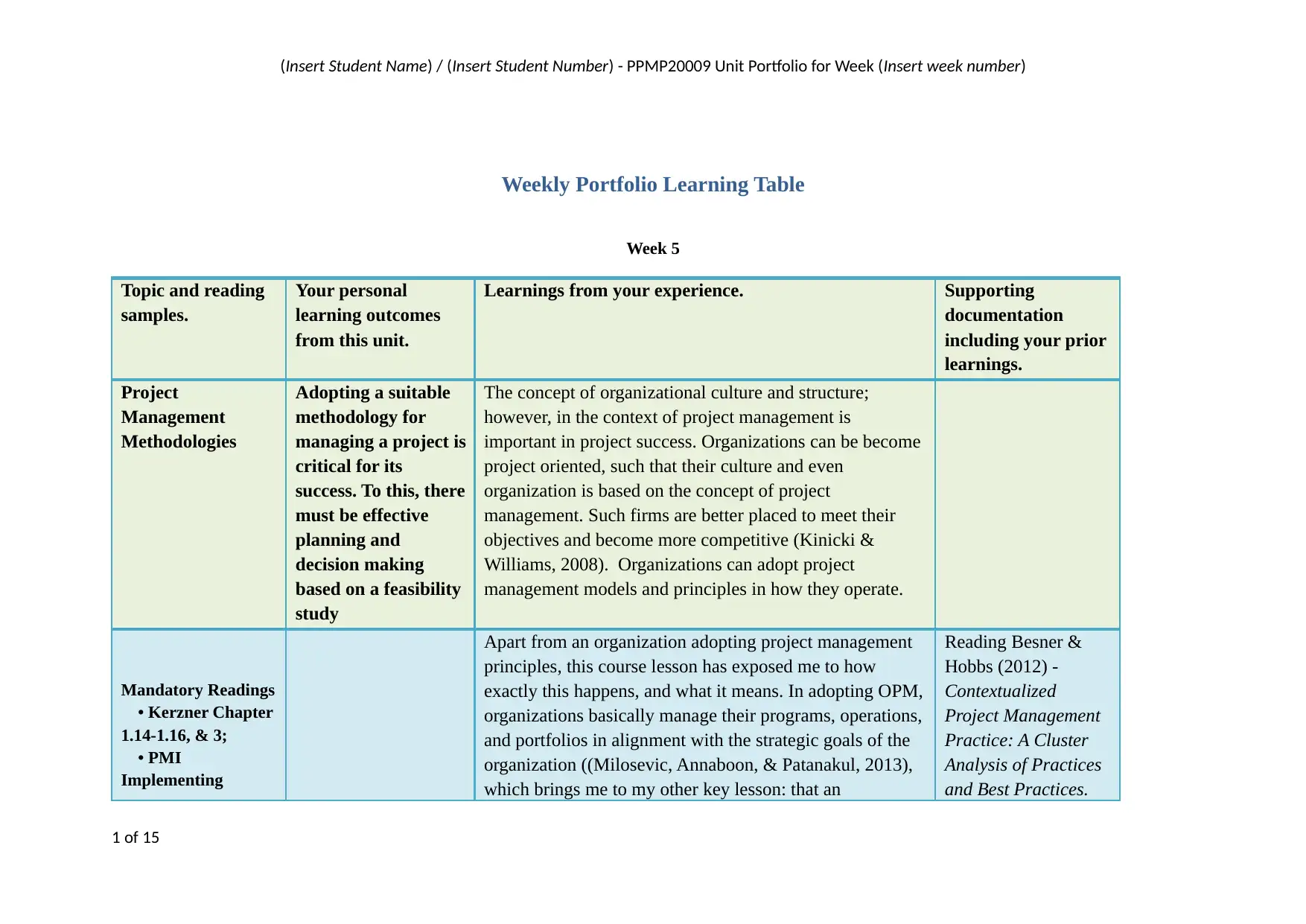
(Insert Student Name) / (Insert Student Number) - PPMP20009 Unit Portfolio for Week (Insert week number)
Weekly Portfolio Learning Table
Week 5
Topic and reading
samples.
Your personal
learning outcomes
from this unit.
Learnings from your experience. Supporting
documentation
including your prior
learnings.
Project
Management
Methodologies
Adopting a suitable
methodology for
managing a project is
critical for its
success. To this, there
must be effective
planning and
decision making
based on a feasibility
study
The concept of organizational culture and structure;
however, in the context of project management is
important in project success. Organizations can be become
project oriented, such that their culture and even
organization is based on the concept of project
management. Such firms are better placed to meet their
objectives and become more competitive (Kinicki &
Williams, 2008). Organizations can adopt project
management models and principles in how they operate.
Mandatory Readings
• Kerzner Chapter
1.14-1.16, & 3;
• PMI
Implementing
Apart from an organization adopting project management
principles, this course lesson has exposed me to how
exactly this happens, and what it means. In adopting OPM,
organizations basically manage their programs, operations,
and portfolios in alignment with the strategic goals of the
organization ((Milosevic, Annaboon, & Patanakul, 2013),
which brings me to my other key lesson: that an
Reading Besner &
Hobbs (2012) -
Contextualized
Project Management
Practice: A Cluster
Analysis of Practices
and Best Practices.
1 of 15
Weekly Portfolio Learning Table
Week 5
Topic and reading
samples.
Your personal
learning outcomes
from this unit.
Learnings from your experience. Supporting
documentation
including your prior
learnings.
Project
Management
Methodologies
Adopting a suitable
methodology for
managing a project is
critical for its
success. To this, there
must be effective
planning and
decision making
based on a feasibility
study
The concept of organizational culture and structure;
however, in the context of project management is
important in project success. Organizations can be become
project oriented, such that their culture and even
organization is based on the concept of project
management. Such firms are better placed to meet their
objectives and become more competitive (Kinicki &
Williams, 2008). Organizations can adopt project
management models and principles in how they operate.
Mandatory Readings
• Kerzner Chapter
1.14-1.16, & 3;
• PMI
Implementing
Apart from an organization adopting project management
principles, this course lesson has exposed me to how
exactly this happens, and what it means. In adopting OPM,
organizations basically manage their programs, operations,
and portfolios in alignment with the strategic goals of the
organization ((Milosevic, Annaboon, & Patanakul, 2013),
which brings me to my other key lesson: that an
Reading Besner &
Hobbs (2012) -
Contextualized
Project Management
Practice: A Cluster
Analysis of Practices
and Best Practices.
1 of 15
Paraphrase This Document
Need a fresh take? Get an instant paraphrase of this document with our AI Paraphraser

(Insert Student Name) / (Insert Student Number) - PPMP20009 Unit Portfolio for Week (Insert week number)
Topic and reading
samples.
Your personal
learning outcomes
from this unit.
Learnings from your experience. Supporting
documentation
including your prior
learnings.
OrganizationalPM
Chapter 2
organization that has adopted the OPM model is
considered so only when its strategic goals are aligned with
OPM principles and approaches (Mossalam & Arafa,
2017). I have come to the understanding that OPM is a
new and dynamic management sphere where the dynamic
structures within an organization are articulated as means
by which corporate objectives are implemented through
projects in order to maximize value, as Williams (2011)
alludes.
OPM must go further
and take into account
the industry,
organizational
context, and
geographical location;
that OPM has a
maturity model that
shows how well a
firm has ‘matured’ its
OPM
Journals and
Standards
IJPM Organizational change For effective implementation of OPM into organizations,
change management plays a vital role in ensuring success
and so project managers must be fully conversant with it
(organizational change management)
Henry A Hornstein (2015):
The integration of project
management and
organizational change
management is now a
necessity
PMJ OPM strategies should be
used with business specific
techniques and processes
An effective method for managing projects ought to
integrate best practices, including using the best
methodology for implementing OPM with business
specific techniques and processes
PMI (2014):
Implementing
Organizational Project
Management: A Practice
Guide
SAI Global Aligning strategic goals
with operational plans
Organizations must be aligned with their strategic goals in
2 of 15
Topic and reading
samples.
Your personal
learning outcomes
from this unit.
Learnings from your experience. Supporting
documentation
including your prior
learnings.
OrganizationalPM
Chapter 2
organization that has adopted the OPM model is
considered so only when its strategic goals are aligned with
OPM principles and approaches (Mossalam & Arafa,
2017). I have come to the understanding that OPM is a
new and dynamic management sphere where the dynamic
structures within an organization are articulated as means
by which corporate objectives are implemented through
projects in order to maximize value, as Williams (2011)
alludes.
OPM must go further
and take into account
the industry,
organizational
context, and
geographical location;
that OPM has a
maturity model that
shows how well a
firm has ‘matured’ its
OPM
Journals and
Standards
IJPM Organizational change For effective implementation of OPM into organizations,
change management plays a vital role in ensuring success
and so project managers must be fully conversant with it
(organizational change management)
Henry A Hornstein (2015):
The integration of project
management and
organizational change
management is now a
necessity
PMJ OPM strategies should be
used with business specific
techniques and processes
An effective method for managing projects ought to
integrate best practices, including using the best
methodology for implementing OPM with business
specific techniques and processes
PMI (2014):
Implementing
Organizational Project
Management: A Practice
Guide
SAI Global Aligning strategic goals
with operational plans
Organizations must be aligned with their strategic goals in
2 of 15

(Insert Student Name) / (Insert Student Number) - PPMP20009 Unit Portfolio for Week (Insert week number)
Topic and reading
samples.
Your personal
learning outcomes
from this unit.
Learnings from your experience. Supporting
documentation
including your prior
learnings.
order to attain OPM
Optional Readings
Management Journal
Volume 44 No 1,
pages 17-34 for the
article by Besner C.
& Hobbs B.
(2012)Contextualized
Project Management
Practice: A Cluster
Analysis of Practices
and Best Practices
OPM is a structural paradigm as well as a practice where
organizational culture and practices follow a project
oriented approach. The other lesson is that OM integrates
capability, and will help an organization understand its
objectives better, evaluate its constraints, and develop a
plan of action, based on OPM, that maximizes value, in-
spite of constraints and limitations
3 of 15
Topic and reading
samples.
Your personal
learning outcomes
from this unit.
Learnings from your experience. Supporting
documentation
including your prior
learnings.
order to attain OPM
Optional Readings
Management Journal
Volume 44 No 1,
pages 17-34 for the
article by Besner C.
& Hobbs B.
(2012)Contextualized
Project Management
Practice: A Cluster
Analysis of Practices
and Best Practices
OPM is a structural paradigm as well as a practice where
organizational culture and practices follow a project
oriented approach. The other lesson is that OM integrates
capability, and will help an organization understand its
objectives better, evaluate its constraints, and develop a
plan of action, based on OPM, that maximizes value, in-
spite of constraints and limitations
3 of 15
⊘ This is a preview!⊘
Do you want full access?
Subscribe today to unlock all pages.

Trusted by 1+ million students worldwide
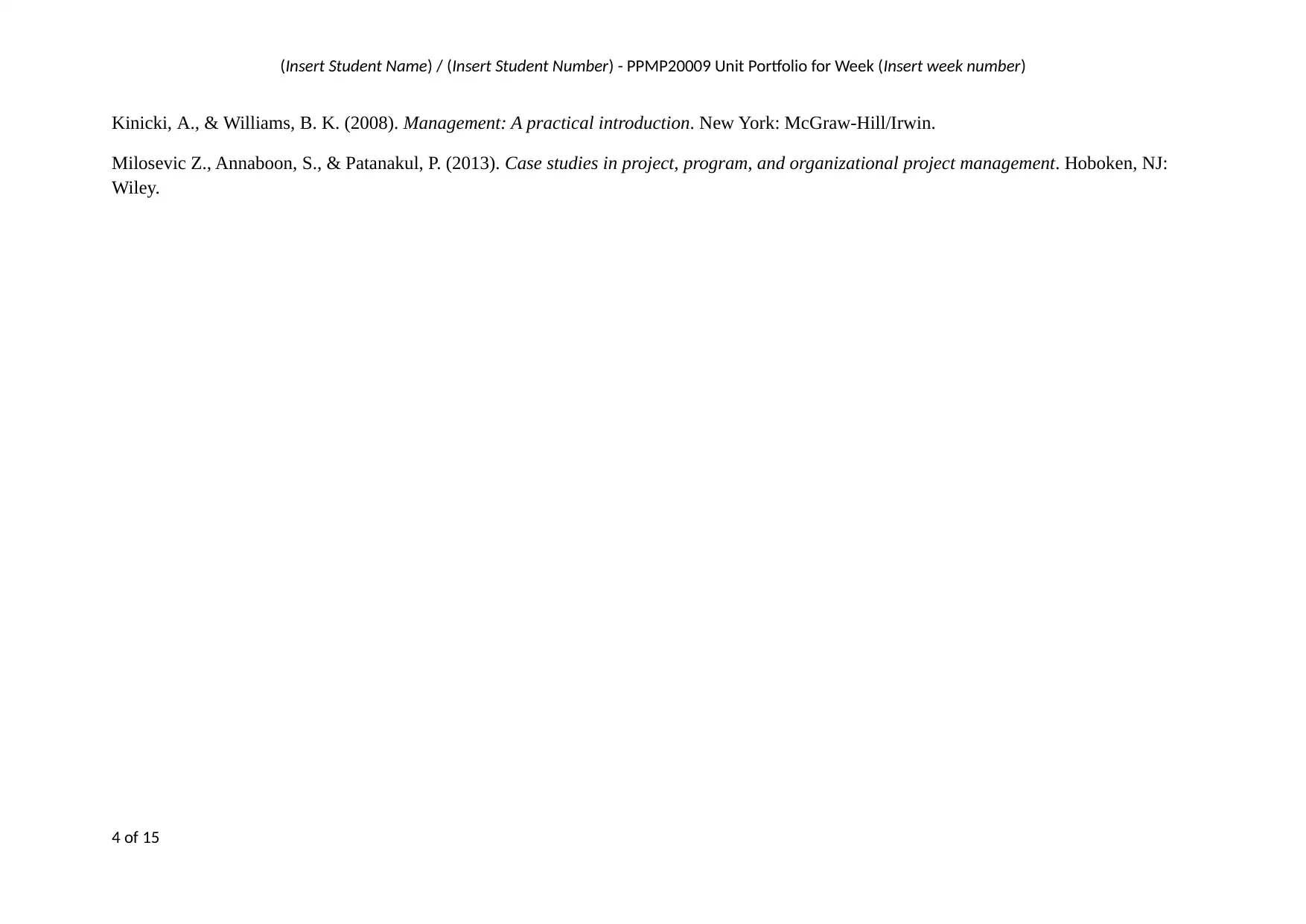
(Insert Student Name) / (Insert Student Number) - PPMP20009 Unit Portfolio for Week (Insert week number)
Kinicki, A., & Williams, B. K. (2008). Management: A practical introduction. New York: McGraw-Hill/Irwin.
Milosevic Z., Annaboon, S., & Patanakul, P. (2013). Case studies in project, program, and organizational project management. Hoboken, NJ:
Wiley.
4 of 15
Kinicki, A., & Williams, B. K. (2008). Management: A practical introduction. New York: McGraw-Hill/Irwin.
Milosevic Z., Annaboon, S., & Patanakul, P. (2013). Case studies in project, program, and organizational project management. Hoboken, NJ:
Wiley.
4 of 15
Paraphrase This Document
Need a fresh take? Get an instant paraphrase of this document with our AI Paraphraser
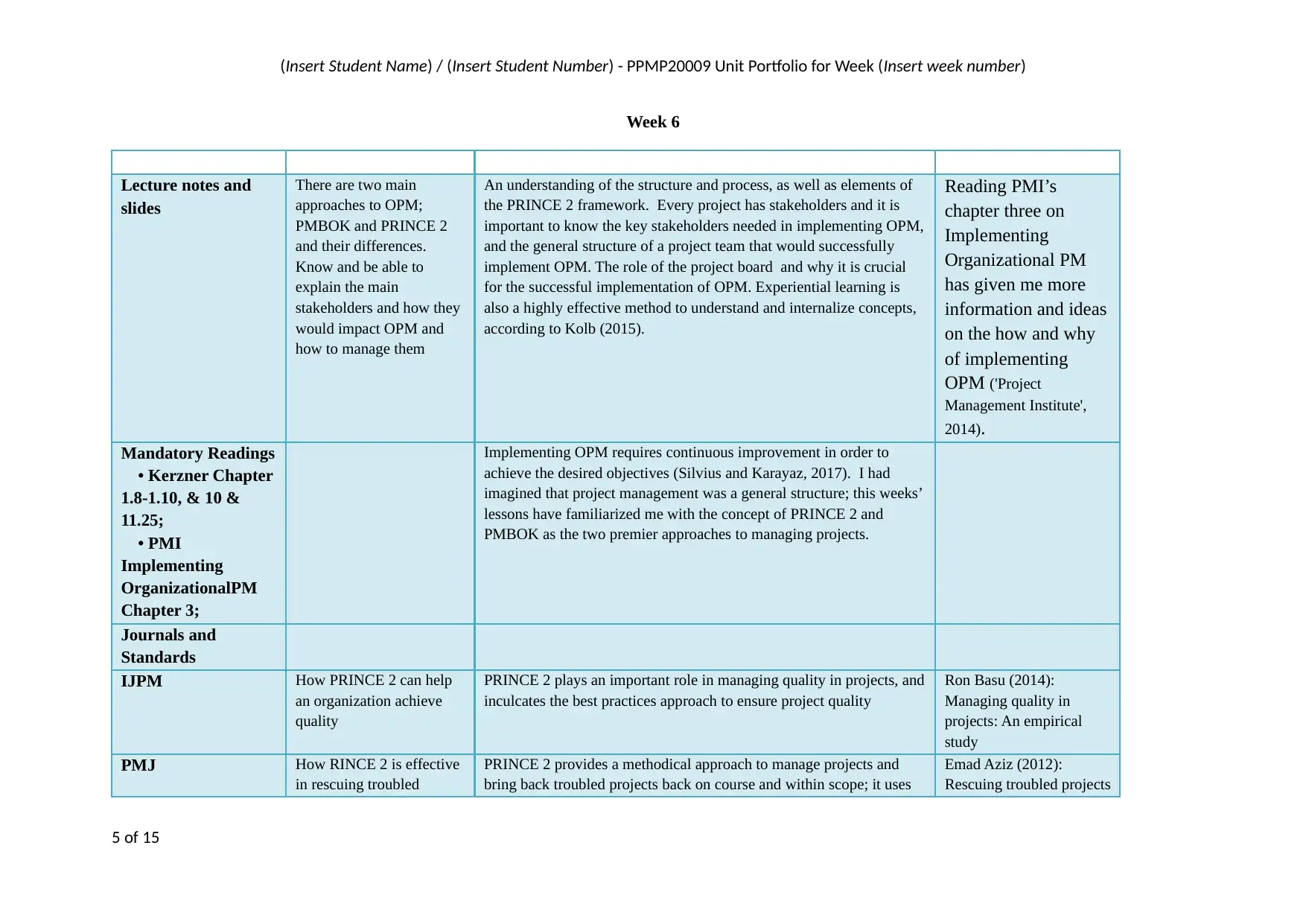
(Insert Student Name) / (Insert Student Number) - PPMP20009 Unit Portfolio for Week (Insert week number)
Week 6
Lecture notes and
slides
There are two main
approaches to OPM;
PMBOK and PRINCE 2
and their differences.
Know and be able to
explain the main
stakeholders and how they
would impact OPM and
how to manage them
An understanding of the structure and process, as well as elements of
the PRINCE 2 framework. Every project has stakeholders and it is
important to know the key stakeholders needed in implementing OPM,
and the general structure of a project team that would successfully
implement OPM. The role of the project board and why it is crucial
for the successful implementation of OPM. Experiential learning is
also a highly effective method to understand and internalize concepts,
according to Kolb (2015).
Reading PMI’s
chapter three on
Implementing
Organizational PM
has given me more
information and ideas
on the how and why
of implementing
OPM ('Project
Management Institute',
2014).
Mandatory Readings
• Kerzner Chapter
1.8-1.10, & 10 &
11.25;
• PMI
Implementing
OrganizationalPM
Chapter 3;
Implementing OPM requires continuous improvement in order to
achieve the desired objectives (Silvius and Karayaz, 2017). I had
imagined that project management was a general structure; this weeks’
lessons have familiarized me with the concept of PRINCE 2 and
PMBOK as the two premier approaches to managing projects.
Journals and
Standards
IJPM How PRINCE 2 can help
an organization achieve
quality
PRINCE 2 plays an important role in managing quality in projects, and
inculcates the best practices approach to ensure project quality
Ron Basu (2014):
Managing quality in
projects: An empirical
study
PMJ How RINCE 2 is effective
in rescuing troubled
PRINCE 2 provides a methodical approach to manage projects and
bring back troubled projects back on course and within scope; it uses
Emad Aziz (2012):
Rescuing troubled projects
5 of 15
Week 6
Lecture notes and
slides
There are two main
approaches to OPM;
PMBOK and PRINCE 2
and their differences.
Know and be able to
explain the main
stakeholders and how they
would impact OPM and
how to manage them
An understanding of the structure and process, as well as elements of
the PRINCE 2 framework. Every project has stakeholders and it is
important to know the key stakeholders needed in implementing OPM,
and the general structure of a project team that would successfully
implement OPM. The role of the project board and why it is crucial
for the successful implementation of OPM. Experiential learning is
also a highly effective method to understand and internalize concepts,
according to Kolb (2015).
Reading PMI’s
chapter three on
Implementing
Organizational PM
has given me more
information and ideas
on the how and why
of implementing
OPM ('Project
Management Institute',
2014).
Mandatory Readings
• Kerzner Chapter
1.8-1.10, & 10 &
11.25;
• PMI
Implementing
OrganizationalPM
Chapter 3;
Implementing OPM requires continuous improvement in order to
achieve the desired objectives (Silvius and Karayaz, 2017). I had
imagined that project management was a general structure; this weeks’
lessons have familiarized me with the concept of PRINCE 2 and
PMBOK as the two premier approaches to managing projects.
Journals and
Standards
IJPM How PRINCE 2 can help
an organization achieve
quality
PRINCE 2 plays an important role in managing quality in projects, and
inculcates the best practices approach to ensure project quality
Ron Basu (2014):
Managing quality in
projects: An empirical
study
PMJ How RINCE 2 is effective
in rescuing troubled
PRINCE 2 provides a methodical approach to manage projects and
bring back troubled projects back on course and within scope; it uses
Emad Aziz (2012):
Rescuing troubled projects
5 of 15
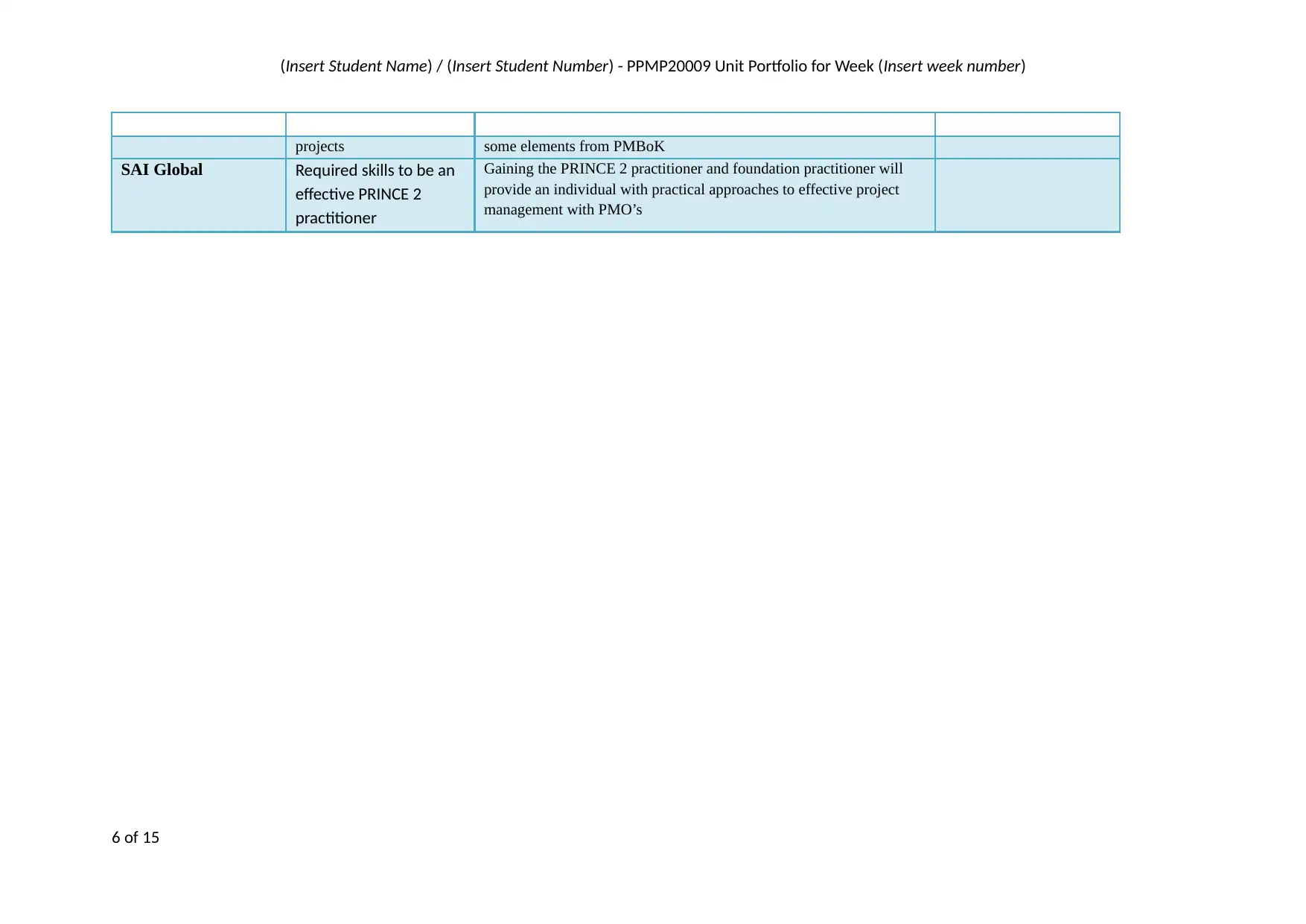
(Insert Student Name) / (Insert Student Number) - PPMP20009 Unit Portfolio for Week (Insert week number)
projects some elements from PMBoK
SAI Global Required skills to be an
effective PRINCE 2
practitioner
Gaining the PRINCE 2 practitioner and foundation practitioner will
provide an individual with practical approaches to effective project
management with PMO’s
6 of 15
projects some elements from PMBoK
SAI Global Required skills to be an
effective PRINCE 2
practitioner
Gaining the PRINCE 2 practitioner and foundation practitioner will
provide an individual with practical approaches to effective project
management with PMO’s
6 of 15
⊘ This is a preview!⊘
Do you want full access?
Subscribe today to unlock all pages.

Trusted by 1+ million students worldwide

(Insert Student Name) / (Insert Student Number) - PPMP20009 Unit Portfolio for Week (Insert week number)
Kolb, D. (2015). Experiential learning. Upper Saddle River, New Jersey: Pearson Education, Inc.
Silvius, G. and Karayaz, G. (2017). Developing organizational maturity for effective project management. Hershey, Pennsylvania: IGI Global.
7 of 15
Kolb, D. (2015). Experiential learning. Upper Saddle River, New Jersey: Pearson Education, Inc.
Silvius, G. and Karayaz, G. (2017). Developing organizational maturity for effective project management. Hershey, Pennsylvania: IGI Global.
7 of 15
Paraphrase This Document
Need a fresh take? Get an instant paraphrase of this document with our AI Paraphraser
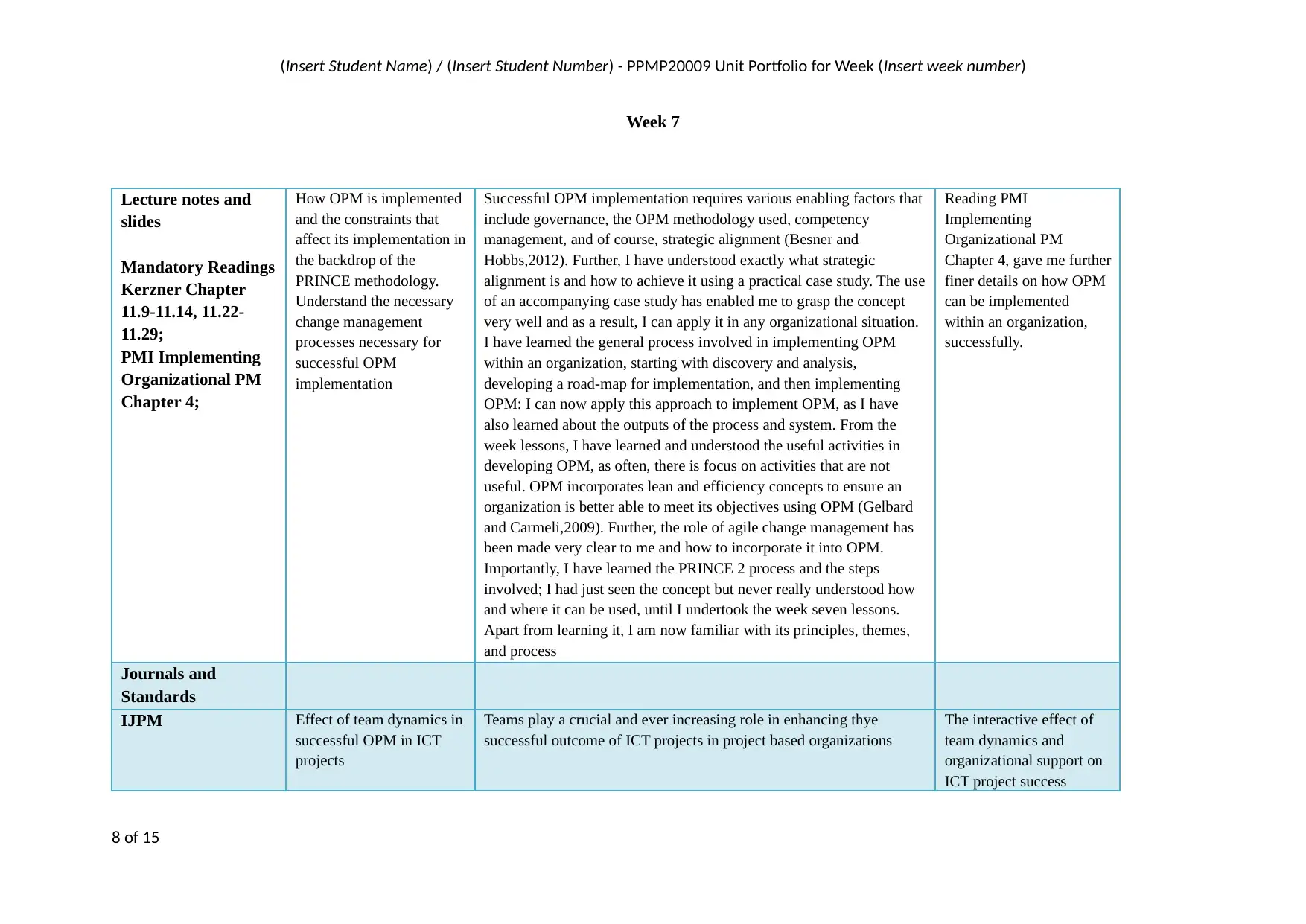
(Insert Student Name) / (Insert Student Number) - PPMP20009 Unit Portfolio for Week (Insert week number)
Week 7
Lecture notes and
slides
Mandatory Readings
Kerzner Chapter
11.9-11.14, 11.22-
11.29;
PMI Implementing
Organizational PM
Chapter 4;
How OPM is implemented
and the constraints that
affect its implementation in
the backdrop of the
PRINCE methodology.
Understand the necessary
change management
processes necessary for
successful OPM
implementation
Successful OPM implementation requires various enabling factors that
include governance, the OPM methodology used, competency
management, and of course, strategic alignment (Besner and
Hobbs,2012). Further, I have understood exactly what strategic
alignment is and how to achieve it using a practical case study. The use
of an accompanying case study has enabled me to grasp the concept
very well and as a result, I can apply it in any organizational situation.
I have learned the general process involved in implementing OPM
within an organization, starting with discovery and analysis,
developing a road-map for implementation, and then implementing
OPM: I can now apply this approach to implement OPM, as I have
also learned about the outputs of the process and system. From the
week lessons, I have learned and understood the useful activities in
developing OPM, as often, there is focus on activities that are not
useful. OPM incorporates lean and efficiency concepts to ensure an
organization is better able to meet its objectives using OPM (Gelbard
and Carmeli,2009). Further, the role of agile change management has
been made very clear to me and how to incorporate it into OPM.
Importantly, I have learned the PRINCE 2 process and the steps
involved; I had just seen the concept but never really understood how
and where it can be used, until I undertook the week seven lessons.
Apart from learning it, I am now familiar with its principles, themes,
and process
Reading PMI
Implementing
Organizational PM
Chapter 4, gave me further
finer details on how OPM
can be implemented
within an organization,
successfully.
Journals and
Standards
IJPM Effect of team dynamics in
successful OPM in ICT
projects
Teams play a crucial and ever increasing role in enhancing thye
successful outcome of ICT projects in project based organizations
The interactive effect of
team dynamics and
organizational support on
ICT project success
8 of 15
Week 7
Lecture notes and
slides
Mandatory Readings
Kerzner Chapter
11.9-11.14, 11.22-
11.29;
PMI Implementing
Organizational PM
Chapter 4;
How OPM is implemented
and the constraints that
affect its implementation in
the backdrop of the
PRINCE methodology.
Understand the necessary
change management
processes necessary for
successful OPM
implementation
Successful OPM implementation requires various enabling factors that
include governance, the OPM methodology used, competency
management, and of course, strategic alignment (Besner and
Hobbs,2012). Further, I have understood exactly what strategic
alignment is and how to achieve it using a practical case study. The use
of an accompanying case study has enabled me to grasp the concept
very well and as a result, I can apply it in any organizational situation.
I have learned the general process involved in implementing OPM
within an organization, starting with discovery and analysis,
developing a road-map for implementation, and then implementing
OPM: I can now apply this approach to implement OPM, as I have
also learned about the outputs of the process and system. From the
week lessons, I have learned and understood the useful activities in
developing OPM, as often, there is focus on activities that are not
useful. OPM incorporates lean and efficiency concepts to ensure an
organization is better able to meet its objectives using OPM (Gelbard
and Carmeli,2009). Further, the role of agile change management has
been made very clear to me and how to incorporate it into OPM.
Importantly, I have learned the PRINCE 2 process and the steps
involved; I had just seen the concept but never really understood how
and where it can be used, until I undertook the week seven lessons.
Apart from learning it, I am now familiar with its principles, themes,
and process
Reading PMI
Implementing
Organizational PM
Chapter 4, gave me further
finer details on how OPM
can be implemented
within an organization,
successfully.
Journals and
Standards
IJPM Effect of team dynamics in
successful OPM in ICT
projects
Teams play a crucial and ever increasing role in enhancing thye
successful outcome of ICT projects in project based organizations
The interactive effect of
team dynamics and
organizational support on
ICT project success
8 of 15
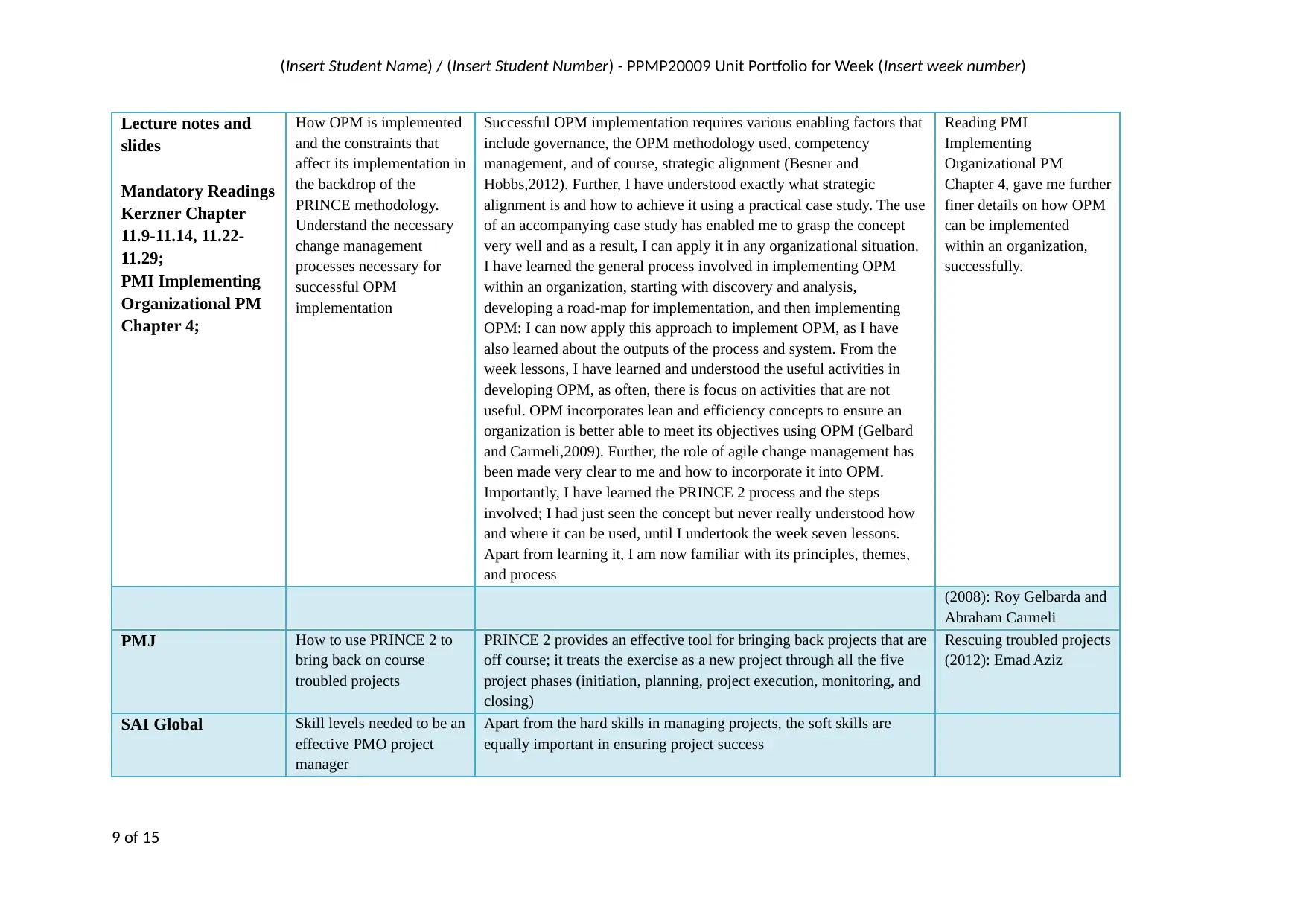
(Insert Student Name) / (Insert Student Number) - PPMP20009 Unit Portfolio for Week (Insert week number)
Lecture notes and
slides
Mandatory Readings
Kerzner Chapter
11.9-11.14, 11.22-
11.29;
PMI Implementing
Organizational PM
Chapter 4;
How OPM is implemented
and the constraints that
affect its implementation in
the backdrop of the
PRINCE methodology.
Understand the necessary
change management
processes necessary for
successful OPM
implementation
Successful OPM implementation requires various enabling factors that
include governance, the OPM methodology used, competency
management, and of course, strategic alignment (Besner and
Hobbs,2012). Further, I have understood exactly what strategic
alignment is and how to achieve it using a practical case study. The use
of an accompanying case study has enabled me to grasp the concept
very well and as a result, I can apply it in any organizational situation.
I have learned the general process involved in implementing OPM
within an organization, starting with discovery and analysis,
developing a road-map for implementation, and then implementing
OPM: I can now apply this approach to implement OPM, as I have
also learned about the outputs of the process and system. From the
week lessons, I have learned and understood the useful activities in
developing OPM, as often, there is focus on activities that are not
useful. OPM incorporates lean and efficiency concepts to ensure an
organization is better able to meet its objectives using OPM (Gelbard
and Carmeli,2009). Further, the role of agile change management has
been made very clear to me and how to incorporate it into OPM.
Importantly, I have learned the PRINCE 2 process and the steps
involved; I had just seen the concept but never really understood how
and where it can be used, until I undertook the week seven lessons.
Apart from learning it, I am now familiar with its principles, themes,
and process
Reading PMI
Implementing
Organizational PM
Chapter 4, gave me further
finer details on how OPM
can be implemented
within an organization,
successfully.
(2008): Roy Gelbarda and
Abraham Carmeli
PMJ How to use PRINCE 2 to
bring back on course
troubled projects
PRINCE 2 provides an effective tool for bringing back projects that are
off course; it treats the exercise as a new project through all the five
project phases (initiation, planning, project execution, monitoring, and
closing)
Rescuing troubled projects
(2012): Emad Aziz
SAI Global Skill levels needed to be an
effective PMO project
manager
Apart from the hard skills in managing projects, the soft skills are
equally important in ensuring project success
9 of 15
Lecture notes and
slides
Mandatory Readings
Kerzner Chapter
11.9-11.14, 11.22-
11.29;
PMI Implementing
Organizational PM
Chapter 4;
How OPM is implemented
and the constraints that
affect its implementation in
the backdrop of the
PRINCE methodology.
Understand the necessary
change management
processes necessary for
successful OPM
implementation
Successful OPM implementation requires various enabling factors that
include governance, the OPM methodology used, competency
management, and of course, strategic alignment (Besner and
Hobbs,2012). Further, I have understood exactly what strategic
alignment is and how to achieve it using a practical case study. The use
of an accompanying case study has enabled me to grasp the concept
very well and as a result, I can apply it in any organizational situation.
I have learned the general process involved in implementing OPM
within an organization, starting with discovery and analysis,
developing a road-map for implementation, and then implementing
OPM: I can now apply this approach to implement OPM, as I have
also learned about the outputs of the process and system. From the
week lessons, I have learned and understood the useful activities in
developing OPM, as often, there is focus on activities that are not
useful. OPM incorporates lean and efficiency concepts to ensure an
organization is better able to meet its objectives using OPM (Gelbard
and Carmeli,2009). Further, the role of agile change management has
been made very clear to me and how to incorporate it into OPM.
Importantly, I have learned the PRINCE 2 process and the steps
involved; I had just seen the concept but never really understood how
and where it can be used, until I undertook the week seven lessons.
Apart from learning it, I am now familiar with its principles, themes,
and process
Reading PMI
Implementing
Organizational PM
Chapter 4, gave me further
finer details on how OPM
can be implemented
within an organization,
successfully.
(2008): Roy Gelbarda and
Abraham Carmeli
PMJ How to use PRINCE 2 to
bring back on course
troubled projects
PRINCE 2 provides an effective tool for bringing back projects that are
off course; it treats the exercise as a new project through all the five
project phases (initiation, planning, project execution, monitoring, and
closing)
Rescuing troubled projects
(2012): Emad Aziz
SAI Global Skill levels needed to be an
effective PMO project
manager
Apart from the hard skills in managing projects, the soft skills are
equally important in ensuring project success
9 of 15
⊘ This is a preview!⊘
Do you want full access?
Subscribe today to unlock all pages.

Trusted by 1+ million students worldwide
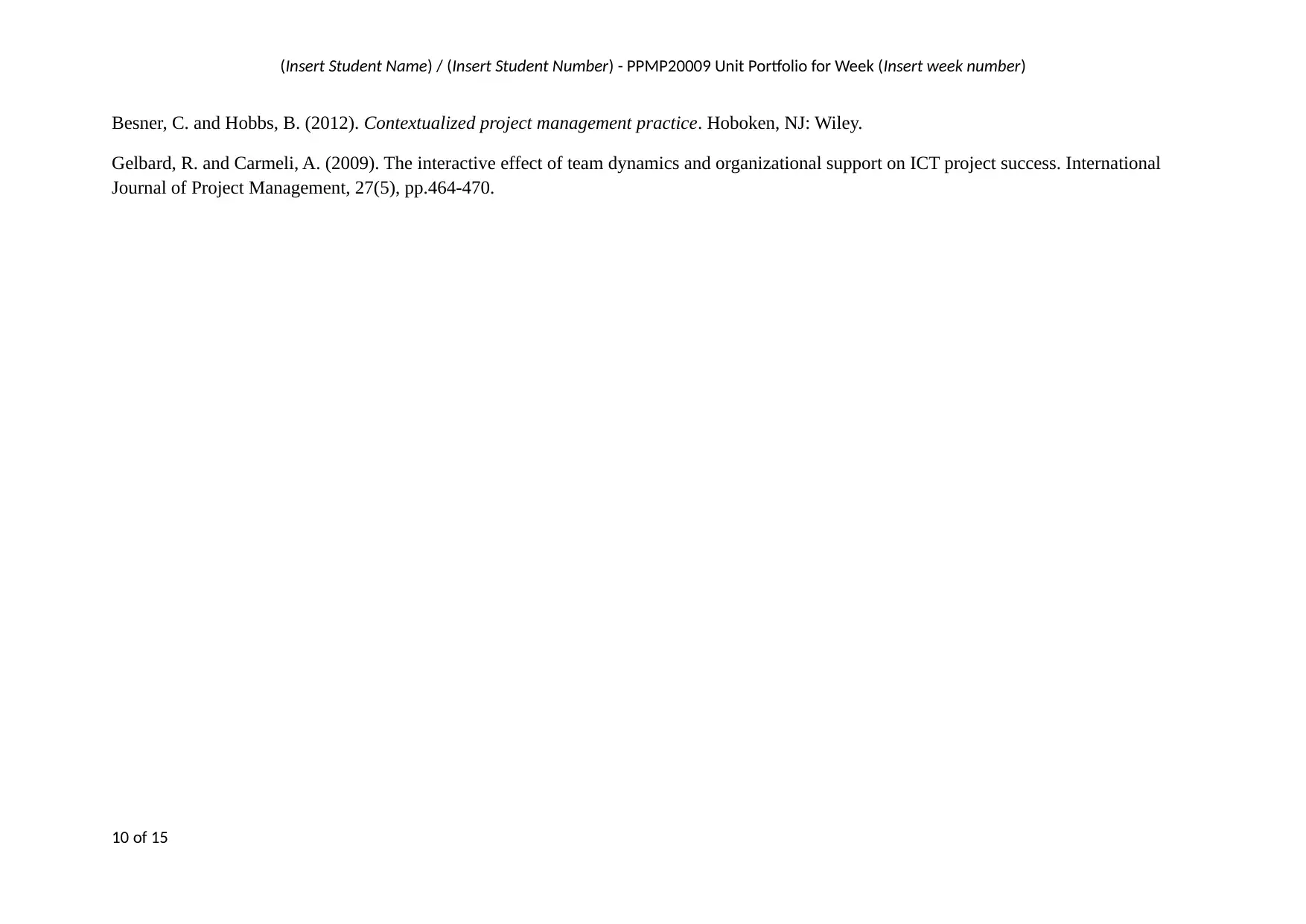
(Insert Student Name) / (Insert Student Number) - PPMP20009 Unit Portfolio for Week (Insert week number)
Besner, C. and Hobbs, B. (2012). Contextualized project management practice. Hoboken, NJ: Wiley.
Gelbard, R. and Carmeli, A. (2009). The interactive effect of team dynamics and organizational support on ICT project success. International
Journal of Project Management, 27(5), pp.464-470.
10 of 15
Besner, C. and Hobbs, B. (2012). Contextualized project management practice. Hoboken, NJ: Wiley.
Gelbard, R. and Carmeli, A. (2009). The interactive effect of team dynamics and organizational support on ICT project success. International
Journal of Project Management, 27(5), pp.464-470.
10 of 15
Paraphrase This Document
Need a fresh take? Get an instant paraphrase of this document with our AI Paraphraser

(Insert Student Name) / (Insert Student Number) - PPMP20009 Unit Portfolio for Week (Insert week number)
Week 8
Lecture notes and
slides
Mandatory Readings
Kerzner
Chapter11.0-11.8;
PMI Implementing
OrganizationalPM
Chapter 5;
Suitable tools used for
implementing OPM,
including developing the
WBS, the required inputs
and outputs, and the
differences between
outputs and outcomes in
the context of OPM
implementation.
I have managed to understand the WBS concept, and attendant tools
for managing projects, including the Work packages, and the WBS
dictionary and why they are important in a project, including
implementing OPM (Williams, 2011). I had thought that developing
goals for a project, determining how to undertake the project, and
undertaking and reviewing the project were sufficient in executing a
project. However, the week eight course materials have taught me that
there is a systematic process to undertake a project, such as when
developing software, with activities and steps that must be followed to
the end (SDLC). I have also known how the basic project management
processes apply when one is using the SDLC approach to run and
manage a project (Brewer, 2018). The practical group work gave me
further practical experience and a taste of just how the project
management methodology and principles should be applied when
undertaking a project. I feel I am a much better and knowledgeable
student f project management; I understand the concepts,
methodologies, why they are important for OPM, and using the SDLC
in undertaking projects. Further, I understand the process of
developing a desired state through undertaking a gap analysis; prior to
the week, I though objectives are just randomly developed: in this
week’s course, I have learned that there is a systematic way in which to
develop project objectives and execute a project to achieve those
objectives, using structured tools and project management
methodologies
Reading PMI’s
Implementing
Organizational PM
Chapter 5 has also given
me new and detailed
perspectives and the
rationale in the
implementation of OPM
Journals and
Standards
IJPM Tools for OPM
implementation
Various tools work synergistically with PRINCE 2 concepts to deliver
successful projects
Adoption of project
management practices:
The impact on
international development
projects of non-
11 of 15
Week 8
Lecture notes and
slides
Mandatory Readings
Kerzner
Chapter11.0-11.8;
PMI Implementing
OrganizationalPM
Chapter 5;
Suitable tools used for
implementing OPM,
including developing the
WBS, the required inputs
and outputs, and the
differences between
outputs and outcomes in
the context of OPM
implementation.
I have managed to understand the WBS concept, and attendant tools
for managing projects, including the Work packages, and the WBS
dictionary and why they are important in a project, including
implementing OPM (Williams, 2011). I had thought that developing
goals for a project, determining how to undertake the project, and
undertaking and reviewing the project were sufficient in executing a
project. However, the week eight course materials have taught me that
there is a systematic process to undertake a project, such as when
developing software, with activities and steps that must be followed to
the end (SDLC). I have also known how the basic project management
processes apply when one is using the SDLC approach to run and
manage a project (Brewer, 2018). The practical group work gave me
further practical experience and a taste of just how the project
management methodology and principles should be applied when
undertaking a project. I feel I am a much better and knowledgeable
student f project management; I understand the concepts,
methodologies, why they are important for OPM, and using the SDLC
in undertaking projects. Further, I understand the process of
developing a desired state through undertaking a gap analysis; prior to
the week, I though objectives are just randomly developed: in this
week’s course, I have learned that there is a systematic way in which to
develop project objectives and execute a project to achieve those
objectives, using structured tools and project management
methodologies
Reading PMI’s
Implementing
Organizational PM
Chapter 5 has also given
me new and detailed
perspectives and the
rationale in the
implementation of OPM
Journals and
Standards
IJPM Tools for OPM
implementation
Various tools work synergistically with PRINCE 2 concepts to deliver
successful projects
Adoption of project
management practices:
The impact on
international development
projects of non-
11 of 15
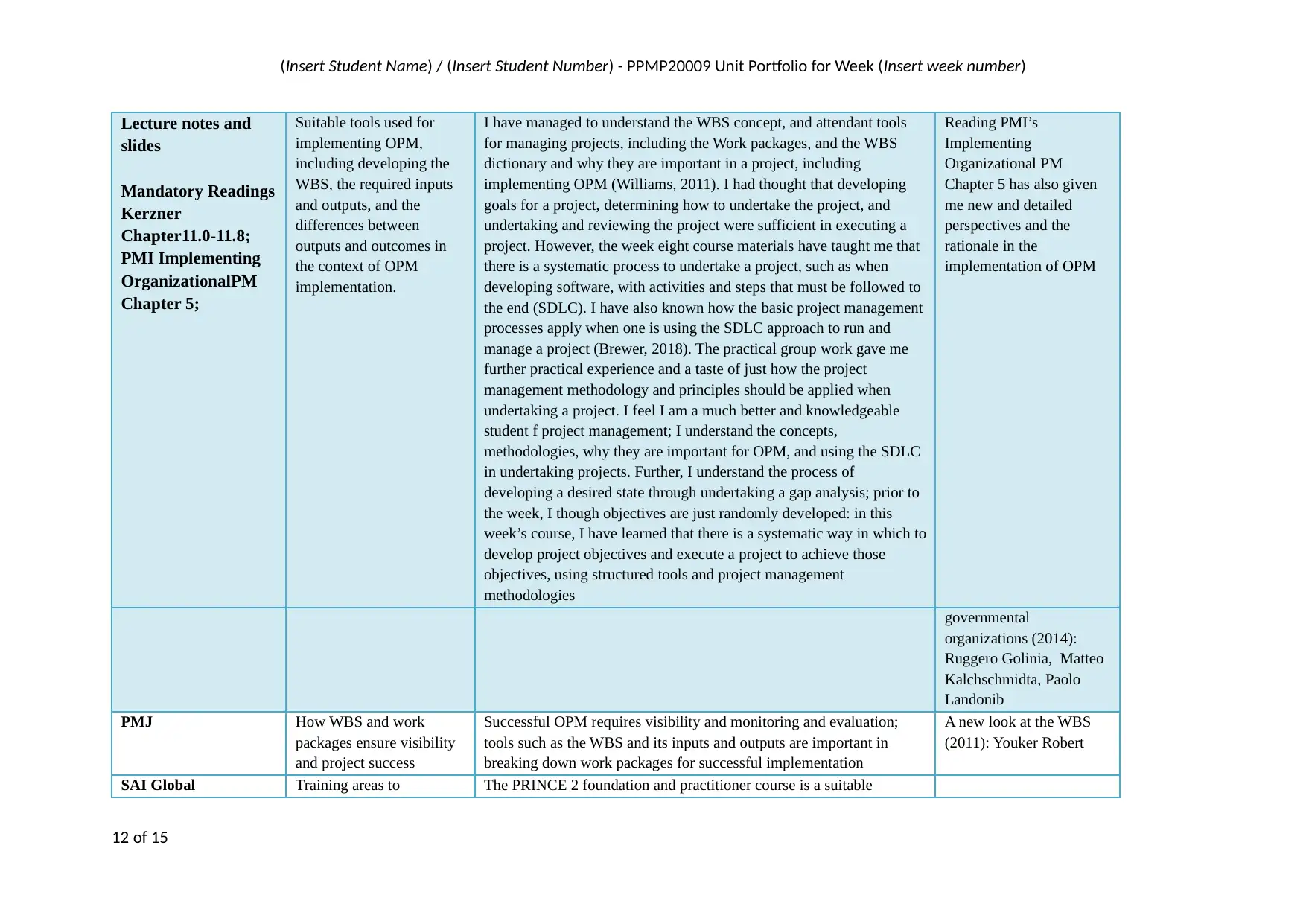
(Insert Student Name) / (Insert Student Number) - PPMP20009 Unit Portfolio for Week (Insert week number)
Lecture notes and
slides
Mandatory Readings
Kerzner
Chapter11.0-11.8;
PMI Implementing
OrganizationalPM
Chapter 5;
Suitable tools used for
implementing OPM,
including developing the
WBS, the required inputs
and outputs, and the
differences between
outputs and outcomes in
the context of OPM
implementation.
I have managed to understand the WBS concept, and attendant tools
for managing projects, including the Work packages, and the WBS
dictionary and why they are important in a project, including
implementing OPM (Williams, 2011). I had thought that developing
goals for a project, determining how to undertake the project, and
undertaking and reviewing the project were sufficient in executing a
project. However, the week eight course materials have taught me that
there is a systematic process to undertake a project, such as when
developing software, with activities and steps that must be followed to
the end (SDLC). I have also known how the basic project management
processes apply when one is using the SDLC approach to run and
manage a project (Brewer, 2018). The practical group work gave me
further practical experience and a taste of just how the project
management methodology and principles should be applied when
undertaking a project. I feel I am a much better and knowledgeable
student f project management; I understand the concepts,
methodologies, why they are important for OPM, and using the SDLC
in undertaking projects. Further, I understand the process of
developing a desired state through undertaking a gap analysis; prior to
the week, I though objectives are just randomly developed: in this
week’s course, I have learned that there is a systematic way in which to
develop project objectives and execute a project to achieve those
objectives, using structured tools and project management
methodologies
Reading PMI’s
Implementing
Organizational PM
Chapter 5 has also given
me new and detailed
perspectives and the
rationale in the
implementation of OPM
governmental
organizations (2014):
Ruggero Golinia, Matteo
Kalchschmidta, Paolo
Landonib
PMJ How WBS and work
packages ensure visibility
and project success
Successful OPM requires visibility and monitoring and evaluation;
tools such as the WBS and its inputs and outputs are important in
breaking down work packages for successful implementation
A new look at the WBS
(2011): Youker Robert
SAI Global Training areas to The PRINCE 2 foundation and practitioner course is a suitable
12 of 15
Lecture notes and
slides
Mandatory Readings
Kerzner
Chapter11.0-11.8;
PMI Implementing
OrganizationalPM
Chapter 5;
Suitable tools used for
implementing OPM,
including developing the
WBS, the required inputs
and outputs, and the
differences between
outputs and outcomes in
the context of OPM
implementation.
I have managed to understand the WBS concept, and attendant tools
for managing projects, including the Work packages, and the WBS
dictionary and why they are important in a project, including
implementing OPM (Williams, 2011). I had thought that developing
goals for a project, determining how to undertake the project, and
undertaking and reviewing the project were sufficient in executing a
project. However, the week eight course materials have taught me that
there is a systematic process to undertake a project, such as when
developing software, with activities and steps that must be followed to
the end (SDLC). I have also known how the basic project management
processes apply when one is using the SDLC approach to run and
manage a project (Brewer, 2018). The practical group work gave me
further practical experience and a taste of just how the project
management methodology and principles should be applied when
undertaking a project. I feel I am a much better and knowledgeable
student f project management; I understand the concepts,
methodologies, why they are important for OPM, and using the SDLC
in undertaking projects. Further, I understand the process of
developing a desired state through undertaking a gap analysis; prior to
the week, I though objectives are just randomly developed: in this
week’s course, I have learned that there is a systematic way in which to
develop project objectives and execute a project to achieve those
objectives, using structured tools and project management
methodologies
Reading PMI’s
Implementing
Organizational PM
Chapter 5 has also given
me new and detailed
perspectives and the
rationale in the
implementation of OPM
governmental
organizations (2014):
Ruggero Golinia, Matteo
Kalchschmidta, Paolo
Landonib
PMJ How WBS and work
packages ensure visibility
and project success
Successful OPM requires visibility and monitoring and evaluation;
tools such as the WBS and its inputs and outputs are important in
breaking down work packages for successful implementation
A new look at the WBS
(2011): Youker Robert
SAI Global Training areas to The PRINCE 2 foundation and practitioner course is a suitable
12 of 15
⊘ This is a preview!⊘
Do you want full access?
Subscribe today to unlock all pages.

Trusted by 1+ million students worldwide
1 out of 15
Related Documents
Your All-in-One AI-Powered Toolkit for Academic Success.
+13062052269
info@desklib.com
Available 24*7 on WhatsApp / Email
![[object Object]](/_next/static/media/star-bottom.7253800d.svg)
Unlock your academic potential
Copyright © 2020–2025 A2Z Services. All Rights Reserved. Developed and managed by ZUCOL.





